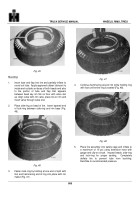TM-5-3805-254-14-P-2 - Page 865 of 894
TRUCK SERVICE MANUAL
WHEELS, RIMS, TIRES
Overinflation is also costly because a tire which
is 20% overinflated will produce only 92% normal tire
mileage.
"Bleeding" of air from hot tires should never be
practiced. The pressure will be reduced but an increase
in temperature will result as soon as driving continues.
Fig. 11
Chart Showing Effects of Bleeding
The chart (Fig. 11) illustrates a condition where a
tire was started cool with a pressure of 70 pounds and at
a temperature of 26.7 degrees C (80 degrees F).
A
-
Initial conditions.
B
-
After 225 km (140 miles) of driving
the pressure had increased to 85
pounds and temperature 93.3 degrees
C (200 degrees F).
C
-
The pressure was then "bled" to 70
pounds and an additional drive made
of 225 km (140 miles). Note the temperature.
D
-
The pressure had increased to 73
pounds while the temperature increased
to approximately 104.4 degrees C (220
degrees F).
E
-
Again "bleeding" was resorted to.
Note the temperature.
F
-
After 322 km (200 miles), the tire
failed from a temperature of over
121.1 degrees C (250 degrees F).
LOADS
Loading tires beyond their rated capacity is
expensive because tire mileages are rapidly decreased
with overloads. The following chart (Fig. 12) illustrates
how an overload of only 20% will result in tire mileage
being only 70% of normal.
Fig. 12
Overload vs. Mileage
856
Back to Top




















